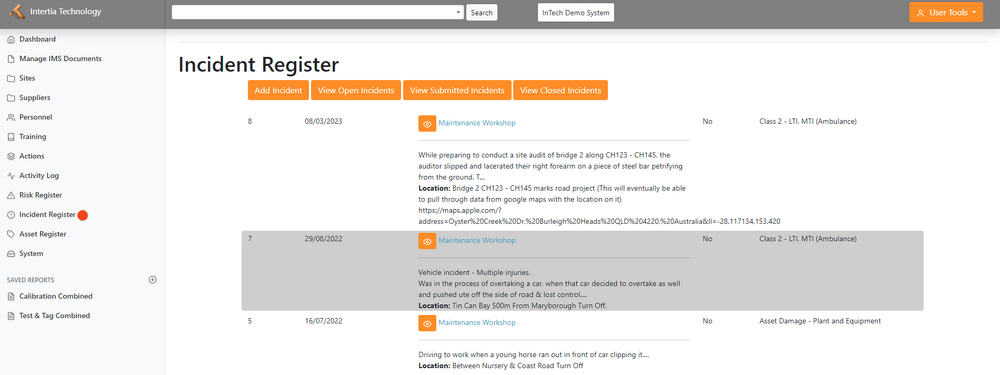Incident Register
Jump to navigation
Jump to search
Reporting an Incident
Viewing the Incident List
- Access the Incident Register page to view a comprehensive list of all the incidents that have occurred in your company. Each incident will be displayed with the date, incident details, and site location, providing an overview of recorded incidents.
Adding a New Incident
To report a new incident, follow these steps:
- Click on the "Add Incident" button.
- Fill out all the necessary information about the incident, including the date, time, type, location, assigned person, reviewer, and details of the incident.
- Ensure that all relevant information is accurately recorded to facilitate proper incident management.
Adding Injured Persons and Witnesses
- Utilize the "People" tab to add the names of any injured persons or witnesses involved in the incident. This helps maintain a comprehensive record of individuals associated with the incident.
Logging Assets, Notes, and Documents
- Use the "Assets," "Notes," and "Documents" tabs to log any assets involved in the incident, add additional notes, or upload relevant documents. This allows for better documentation and reference purposes during incident investigations or reviews.
Close Out the Incident
- Once the incident has been resolved, use the "Close Out" tab to mark the incident as closed. This signifies that appropriate actions have been taken, and the incident no longer requires active management. Closing out incidents helps maintain accurate incident records and supports data analysis for future safety improvements.
Incident Tracking and Resolution
Incident Tracking
- Establish an incident tracking system to record and monitor all reported incidents.
- Assign a unique identification number or code to each incident for easy reference and tracking.
- Maintain a centralized incident register or database to store incident information, including date, time, location, type, severity, and involved individuals.
Incident Investigation
- Conduct thorough investigations of each reported incident to determine its root cause and contributing factors.
- Interview witnesses, gather evidence, and review relevant documents or records to obtain a comprehensive understanding of the incident.
- Use investigative techniques, such as the 5 Whys or Cause and Effect Analysis, to identify underlying causes and develop corrective actions.
Incident Classification and Prioritization
- Classify incidents based on severity, impact, and potential risks.
- Prioritize incidents for resolution based on their level of urgency and potential consequences.
- Allocate appropriate resources and attention to address high-priority incidents promptly.
Incident Resolution and Corrective Action
- Develop a comprehensive action plan to address each incident's root causes and prevent similar incidents from occurring in the future.
- Implement corrective actions and control measures to mitigate identified risks and prevent recurrence.
- Assign responsibilities to individuals or teams for executing the action plan and monitoring their progress.
Communication and Reporting
- Communicate incident findings, actions are taken, and preventive measures to relevant stakeholders.
- Provide timely updates and feedback to individuals affected by the incident to maintain transparency and trust.
- Generate incident reports summarizing key details, actions taken, and lessons learned to support future incident prevention and organizational learning.
Continuous Improvement
- Regularly review incident trends, patterns, and underlying issues to identify areas for improvement.
- Foster a culture of continuous improvement by encouraging employees to report near misses and potential hazards.
- Incorporate incident data and analysis into safety training, policies, and procedures to enhance overall safety performance.
